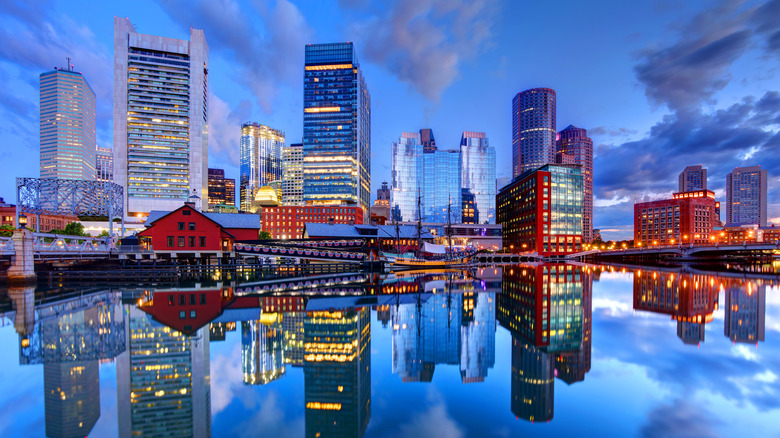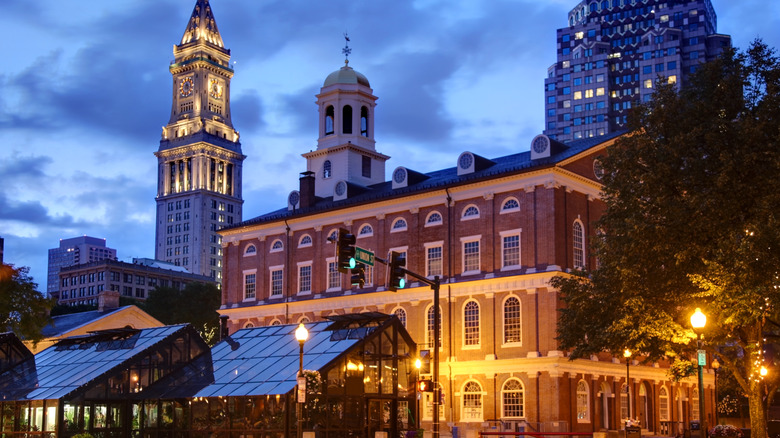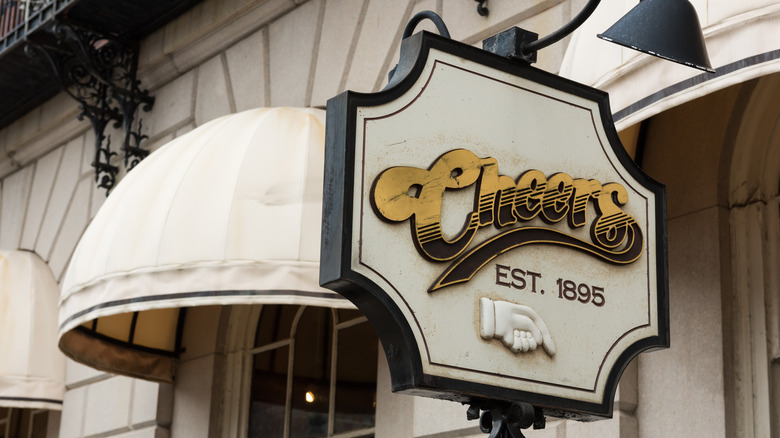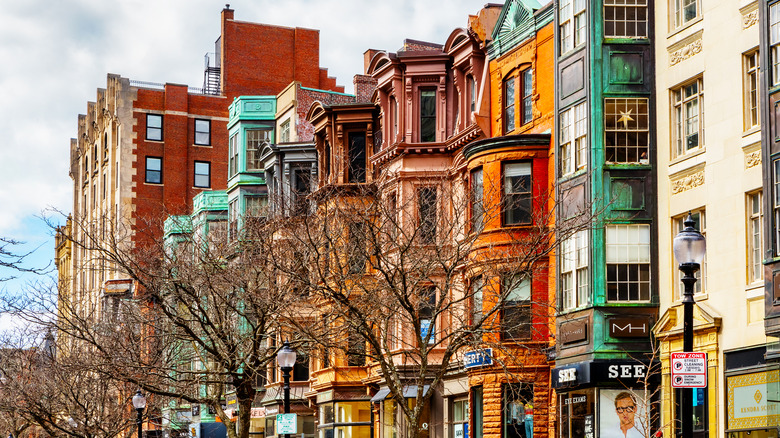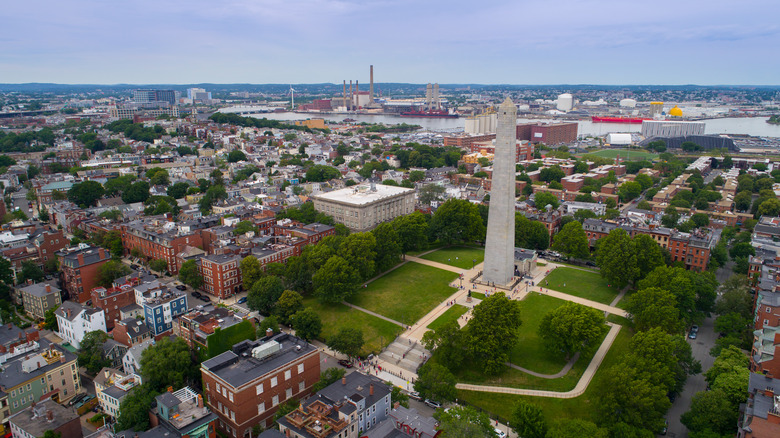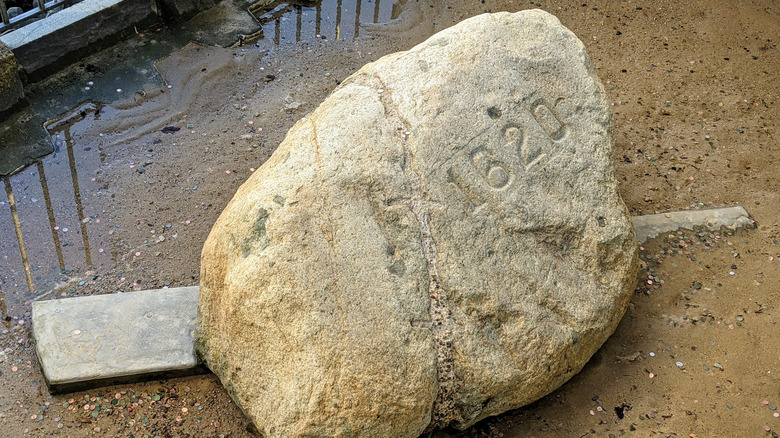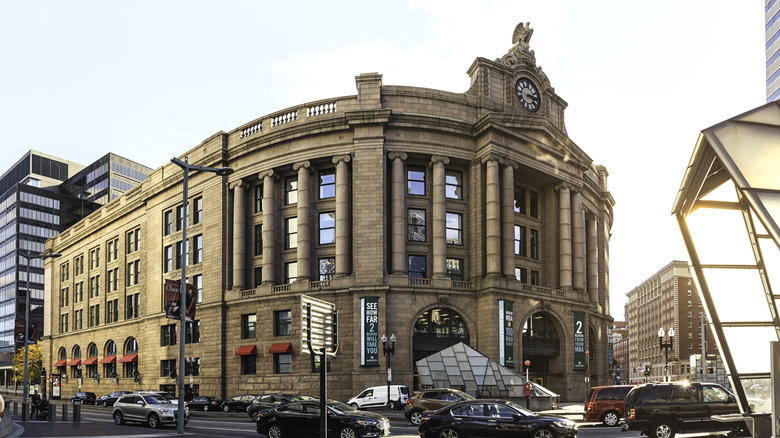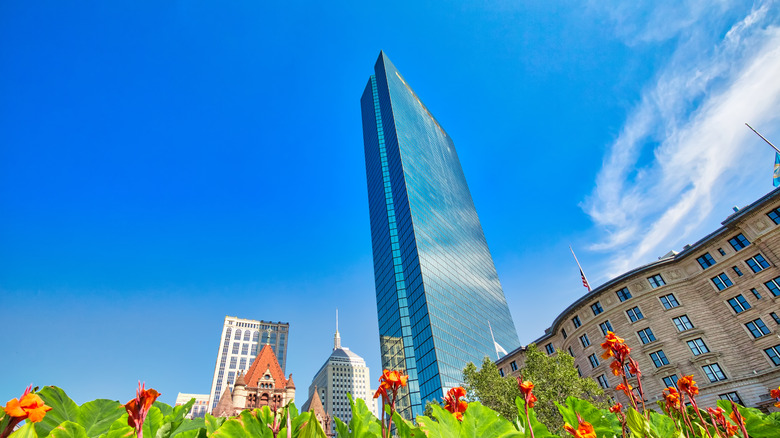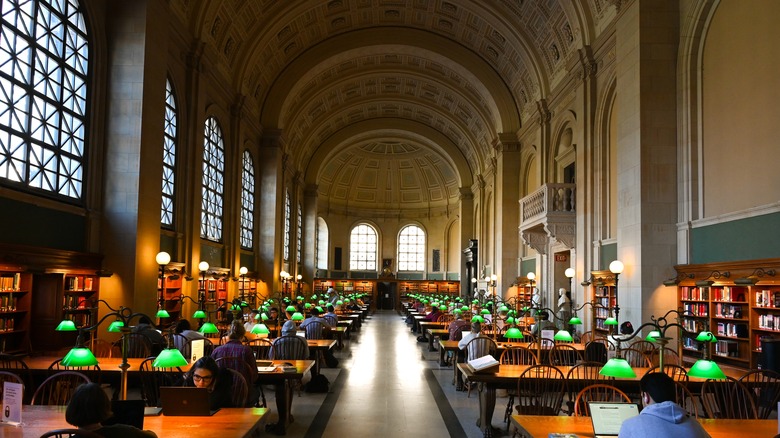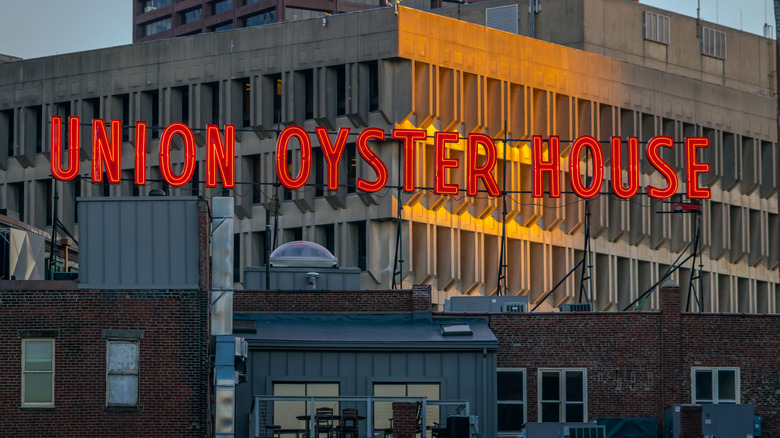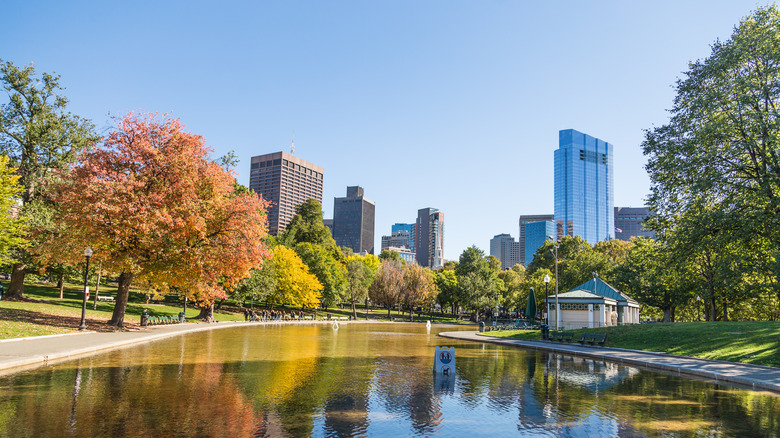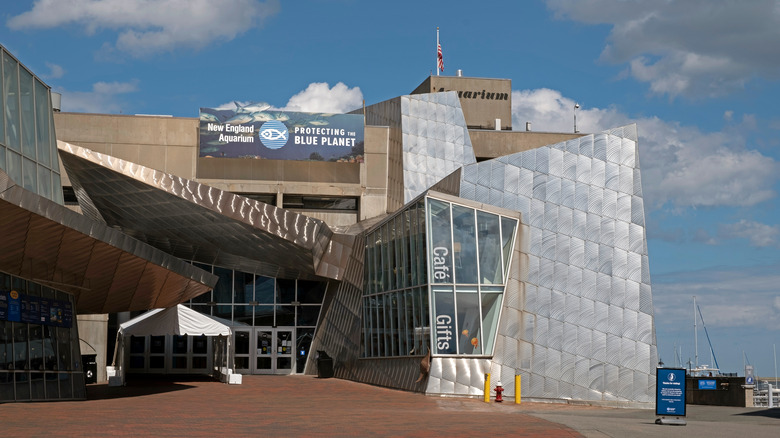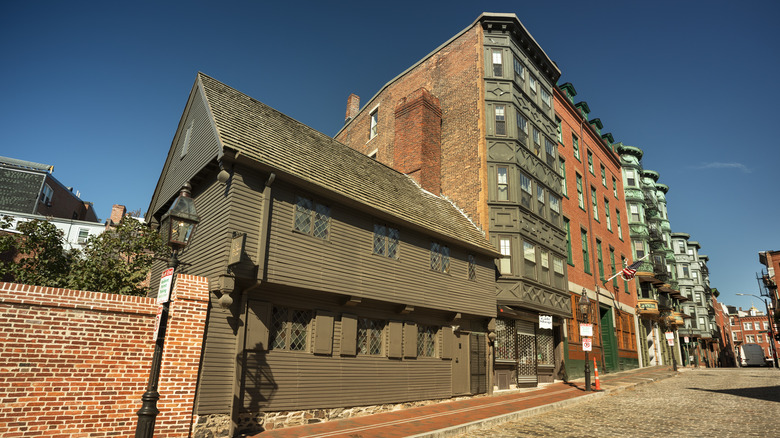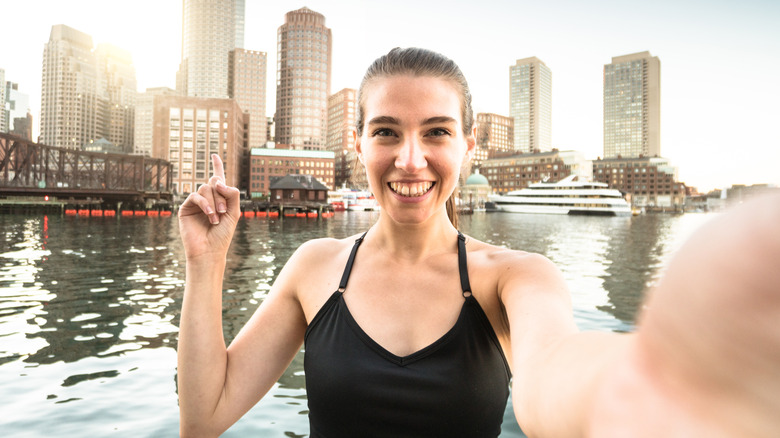Avoid These Tourist Traps On Your Next Trip To Boston, According To Travel Reviews
Boston is one of the most-visited and walkable cities in the U.S., offering a slew of cultural and natural attractions, and many historic landmarks to satisfy every interest. While many of these attractions are must-sees, some are overrun with tourists, making them difficult to access and less-than-pleasant to experience, at least at the wrong times. Still, Boston is filled with many hidden and not-so-hidden gems that are less inundated with tourists — these spots provide just as much fun as the city's well-known tourist traps.
Boston is one of the "smaller" big cities in the U.S., with just under 700,000 residents. But Beantown punches way above its weight when it comes to tourism — according to the City of Boston, more than 22.7 million visitors made a stop in Boston in 2019. To spare savvy Boston visitors the trouble of mingling with selfie stick-wielding, fanny pack-wearing tourists, we scoured travel reviews from TripAdvisor, Google reviews, and local travel experts to keep you clear of Boston tourist traps. We listed related or nearby alternatives for each tourist trap as well.
Don't eat at Faneuil Hall & Quincy Marketplace
Faneuil Hall, open since 1742, and Quincy Market, established in 1826, have long been the center of Boston life and local government. But if you're hangry, go elsewhere. The food options here are not exactly diverse — one Quora reviewer called Faneuil Hall's food offerings "... a couple steps above a prison cafeteria." Quincy Market has been likened to a mall food court, with it being "extremely crowded with thousands of bewildered tourists." Readers told Boston Eater that high rent and high turnover make Faneuil Hall & Quincy Market less than appealing to food vendors, too.
Instead, walk 10 minutes north to Boston's North End, the legendary Italian neighborhood featuring excellent (and mostly Italian) food options. The North End is not a hidden gem — you'll see plenty of tourists trundling up and down Hanover Street. But its top-notch food makes it worth your time.
Head to Lucia's Ristorante, serving homemade Italian classics since 1977. You must try the Lasagna Lucia, Nonna Lucia's own recipe: Pasta layered with egg, ground veal, mozzarella, and tomato sauce. If you don't like it, the answer is yes — Nonna Lucia will be *very* offended. Post-dinner, waddle over to 90-year-old Modern Pastry for one of Boston's famous cannolis. One Google reviewer says Modern Pastry is "as reliable as the bedrock the North End is built on. You could throw a blindfolded dart here and hit something delicious."
Avoid Cheers, where no one knows your name
The Bull & Finch Pub (later renamed Cheers) was the inspiration for the hit NBC sitcom "Cheers." Sure, go ahead and visit the original bar on Beacon Street — but be prepared for disappointment. First off, Sam, Rebecca, Carla, Woody, Frasier, Cliff, and Norm will not be there to greet you. The real-life bar looks nothing like what you see on TV, and even the Cheers replica bar in Faneuil Hall is a poor facsimile of Sam Malone's place. As one TripAdvisor reviewer put it, "I really didn't expect the dark, dingy, and tiny place that it was." Add to that expensive food and the hordes of tourists that flock here (30 years after the show ended, mind you), you'll be better served heading elsewhere for a drink.
Head to The Sevens Ale House, much more of a classic neighborhood pub, with a boisterous ambiance, a dart board, and beer and food prices much lower than Cheers (and just around the corner, too). Fodor's Travel Guide called this neighborhood haunt "a classic dive bar that's an easygoing alternative to Beacon Hill's tony stuffiness." Just the kind of place you'd find Norm, Cliff, and the rest of the "Cheers" gang.
Ditch the tourists flocking to Newbury Street and promenade elsewhere
In chic Back Bay, Newbury Street houses some of Boston's best luxury stores in beautiful brownstones with giant bay windows. But you'll want to avoid this shopping boulevard for its high prices and scant maneuvering space. Newbury is usually packed, parking is hard to find (especially on weekends), and the school year brings college kids en masse. Want to buy something on Newbury? Prepare to spend on a street that one TripAdvisor reviewer called "elegant but PRICEY ... the Rodeo Drive of the East."
Instead, check out Alcorn Street in Beacon Hill, crowned by Architectural Digest as one of the 53 most beautiful streets in the world. Marvel at the street's beautifully maintained Federal Style and Victorian homes, excellent examples of colonial-era Boston architecture.
For a different vibe, cross the Charles River and check out Central Square in Cambridge. Grab a coffee at 1369 Coffee House and stroll this pedestrian-friendly area that, according to one TripAdvisor reviewer, "teems with life, unique thrift shops, record stores, and more eateries than you can imagine." Cambridge is also home to Boston's live music scene — check out Club Passim for folksy tunes, and Middle East for underground and indie music.
Head to the top of the Bunker Hill Monument if you enjoy claustrophobia
The Bunker Hill Monument is a memorial to The Battle of Bunker Hill, the Revolutionary War's opening skirmish on June 17, 1775, fought between British soldiers and New England rebels. The monument is a beautiful, quarried granite obelisk, 221 feet tall surrounded by beautiful grounds. You can climb the nearly 300 steps to the top of the monument to get a view of the city, but multiple reviewers noted the climb is tough, very humid during the summer, and the view is disappointing. One TripAdvisor reviewer also noted the unpleasantness of "scrapping with about 12 other people in 20 square feet for a peak (of downtown Boston)."
Instead, walk 10 minutes east to the USS Constitution, or "Old Ironsides", a nickname earned during the War of 1812 — British cannon balls would harmlessly fall into the water after bouncing off the Constitution's robust oak sides. The Constitution is now the oldest ship afloat, launched in 1797, and remains a training and ceremonial ship for the U.S. Navy. Nearby is the USS Constitution Museum, with all kinds of fun and interactive activities for both adults and kids. One Google reviewer couldn't contain her excitement, saying "I cannot tell you how cool this is in words. Well worth the trip! Grandkids loved it." Tours of the ship and museum are free.
Plymouth Rock is just a rock and you don't need to drive an hour to see it
Just over an hour south of Boston, Plymouth Rock marks the spot where Pilgrims disembarked from The Mayflower in 1620. The boulder is identified with a "1620" chiseled into its face, and it sits in a pit with a viewing platform built around it. More than 1 million tourists trudge down to see Plymouth Rock each year, but is it worth it? It depends — history buffs will appreciate it, but for those who treated history class as nap time in school, it's likely better skipped. As one Google reviewer referred to it as, "the most underwhelming landmark of all time."
If you have a mid-drive epiphany and decide you can't subject your family (or yourself) to an hour's drive to see a rock, take exit 14 off I-93 S and pay a visit to the John F. Kennedy Presidential Library & Museum instead. This beautiful museum and research facility is dedicated to the life and legacy of America's 35th President. Enjoy permanent exhibitions of President Kennedy's finest moments, including his role in defusing the Cuban Missile Crisis and his impact on the U.S. Space Program. There's a permanent exhibition on the iconic First Lady Jackie Kennedy, too. Admission to the JFK Library is $18 for adults, $10 for kids ages 13-17, and free for kids 12 and under.
Gaze at South Station's architecture from afar
A neoclassical masterpiece, South Station's exterior architecture is a sight. South Station is New England's second-largest transit hub, and is a fitting welcome to the throngs of commuters and tourists who enter the city every day. But inside, it's just hordes of panicked travelers desperate to catch their train or bus. Take a good look at South Station's exterior, but don't go inside (unless you need to catch a train).
As Boston is one of the top East Coast cities for art lovers, visit some classically beautiful Boston buildings you'll actually want to enter. The Isabella Stewart Gardner Museum's form was inspired by 15th-century Venetian Gothic architecture, finished in 1902. When its benefactor died in 1924, Gardner's will stipulated that her home, art, and furniture collections be left as is. The seasonally transformed, four-story courtyard is a standout. Its glass roof allows visitors to wander the courtyard even amid Boston's brutal winter.
The Museum of Fine Arts is a Beaux Arts classic and stunning Boston architectural site. Awe-inspiring Ionic columns welcome visitors into a spacious and airy interior. The museum's new, postmodern wing offers an arresting visual juxtaposition to the original building, which opened in 1909. The museum ($27 for adults, $10 for youths 7-17) holds more than 500,000 works of art, which one Google reviewer called "a cultural immersion that transports you across time and space." Don't forget this simple tip to get into museums for free.
Skip expensive Copley Place and head to a Boston outdoor gem instead
We've all felt the call of the mall — there is a time and a place for retail therapy, but Copley Place is not that place. This upscale mall in Back Bay features 75 high-end shops, but it closes early and it is often eerily empty. Even in such a ritzy shopping mall, neither good service nor affordability is on offer, with one Google reviewer remarking that there are "hilariously judgemental staff in just about every store. The up-mark in every store, just because it's in Copley, is honestly quite embarrassing."
Instead of mall-walking, walk 25 minutes west to Fenway Park to tour one of baseball's most hallowed ballparks. Open since 1912, the Boston Red Sox's home is living baseball history. One-hour Fenway tours ($25) run year-round, rain or shine. The Gameday Tour ($40) brings visitors onto the outfield warning track to see how forlorn outfielders feel when home runs sail over their heads. Unfortunately, you won't be able to do your best Oil Can Boyd impression — the warning track is as far as you'll get onto the field. The Pre-Game Tour ($40) brings you to the seats atop the hallowed Green Monster, the towering, 37-foot tall left field wall. Even those you'd least expect to like Fenway tours love them — as one TripAdvisor reviewer put it: "My son and I are lifetime New York Yankees fans and it was still an amazing behind-the-scenes tour." The sky has truly fallen.
Skip the Boston Public Library
The Boston Public Library (BPL), founded in 1848, is the oldest large municipal library system in the country. The BPL remains a popular place — it estimates nearly 4 million people visit every year, including plenty of tourists. Of course, that means any visit to the BPL will likely mean dodging library-goers, travelers, students, and researchers alike. If you're a nerd, the BPL will do. If you're a super nerd (like us), we've got a much better place for you to indulge your bookish proclivities.
The Boston Athenaeum was founded in 1807, and is one of the oldest independent libraries in the country. This five-floor library is membership-only, but that doesn't mean eggheads like you can't get a peek inside. The Athenaeum offers docent-led Art & Architecture tours ($15), giving visitors a gander at one of the most drop-dead gorgeous libraries you'll ever see (apologies to those interred in the cemetery next door). The tour takes you throughout the building, where you'll see two large reading rooms with huge, stunning windows filled with light as well as various other architectural features. The Athenaeum's collection of more than 500,000 books focuses on Boston and New England history, as well as fine arts. The building is filled with cozy reading nooks, spiral staircases, plush reading chairs, sculptures, paintings, and prints. And, of course, beautiful, built-in bookshelves.
Slurp oysters somewhere other than Union Oyster House
Boston's Union Oyster House is America's oldest restaurant and has been shucking oysters since 1826. Daniel Webster downed oysters here in his day. Brookline native John F. Kennedy did the same. But despite its long-running tenure and regal reputation, visiting the Oyster House can be a bit of a hassle. Long waits are common, and neither the food nor the prices measure up. One TripAdvisor put it this way: "What a joke! We waited for over an hour for overpriced mediocre food. Neat place — poke your head in and then go find a good place to eat. This isn't it."
Five minutes north is Neptune Oyster in the North End. True, you will also have to wait in line to get in here, too. But the New York Times named this raw bar one of the top 3 best restaurants in the U.S. in 2020 (it is also one of Boston's best clam chowder spots), so it's probably worth your time. The oysters hit the spot — one Google reviewer reported, "the oysters were super fresh and the taste description for each oyster fit perfectly what I tasted for each." And the lobster rolls? Another Google reviewer nearly died and went to heaven, saying, "I got the lobster roll there and I nearly shed a tear it was so good. I 10/10 recommend this place!" Get a seat at the bar to watch the oyster shuckers do their thing.
Skip Boston Common for a less visited part of Boston's Emerald Necklace
Don't get us wrong — Boston Common is America's oldest park and a historic city location, with a rich history dating back to 1634. This 50-acre downtown park was initially used for animal grazing, rallies, militia formations, and even public hangings. It was only well into the 19th century that Boston Common began to take the shape it holds today. It's beautiful, but it's also busy, with more than 1 million visitors packing the park every year. But there's an equally gorgeous green space worth a visit away from downtown's hustle and bustle.
The less-crowded Arnold Arboretum of Harvard University is a 15-minute drive southwest of downtown in Jamaica Plain, a stunning, 281-acre expanse forming part of Boston's famed Emerald Necklace. One TripAdvisor reviewer called it "a fantastic oasis offering an escape from the city without having to go too far." Not only is the Arnold Arboretum a beautiful place for a stroll in any season, it is Harvard's "living tree museum," home to more than 4,000 types of trees, shrubs, and vines. The Arboretum also boasts an expansive collection, made up of more than 16,000 types of plants, most from expeditions abroad, some native plants, and those grown in the lab by a crack team of Harvard horticulturalists. Docent-led tours are available and run for about 90 minutes. If you can, try to visit in May for the Annual Lilac Sunday Festival.
Ditch the New England Aquarium for a more cutting-edge experience
The New England Aquarium has been a Boston tourist staple since its opening in 1969. Visitors are greeted by the Aquarium's colonies of African and rockhopper penguins, a hoot to watch. Walk further inside to The Ocean Tank, a 40-foot high, 200,000-gallon tank with floor-to-ceiling windows serving as the aquarium's main attraction. It holds more than 1,000 kinds of sea animals. The Ocean Tank is a sight, but not everyone was impressed, with one TripAdvisor commenter saying, "the sharks were really pathetic. It is worth going, but way too expensive." Admission is $34 for adults and $25 for kids 3 to 11. Another knock against the New England Aquarium — it gets busy. Weekends are incredibly crowded, and school field trips invade the place during the week.
For a more relaxed experience, head across the river and visit the MIT Museum. Kids upset about not seeing penguins will enjoy this new museum, and you can easily spend a ton of time here. As one Google reviewer put it, "The exhibits are mind-blowing. We needed to plan at least a few hours in each exhibit. Absolutely captivating." MIT's goal was to show the public all it has been up to and to document MIT's boundary-pushing history. Exhibits covering AI, robotics, photography, holograms, art, and more are showcased, with current MIT students often manning the exhibits and explaining their work. Admission is cheaper than the aquarium: $18 for adults and $10 for kids under the age of 18.
Skip the Paul Revere House, unless you enjoy being cramped in a small space
The Paul Revere House (admission is $6 for adults and $1 for kids) is the last stop on Boston's Freedom Trail, and the oldest building in downtown Boston, built in 1680. Revere left here on his now-famous midnight ride in April 1775, to warn colonists of approaching British forces. This restored Colonial-era home features big fireplaces, open floor plans, and heavy beams — 90% of the structure is original. Revere's home is historically significant, but it is small, and regularly filled with tourists. One TripAdvisor reviewer said, "no one regulates how many people are touring the home at a particular time ... squished in like sardines."
Instead, walk 30 minutes west to Back Bay to visit the Gibson House Museum, a time capsule of domestic Boston living from 1859 through the 1950s and full of original furnishings. The Gibson House is more expensive ($12 for adults and $5 for kids) than Paul Revere's home, but far less crowded. It is a "Victorian townhouse museum that is an absolute hidden gem," according to one Google reviewer. Docent-led tours are available in this home that housed three generations of the Gibson family and house staff. Walk-ins are welcome, but buying tickets in advance is recommended.
Our methodology
Recommendations for Boston tourist traps to avoid, and either similar or nearby alternatives, were sourced from reviews on blogs, online forums, and travel websites. We also consulted expert opinions via Boston-centric websites and publications.
